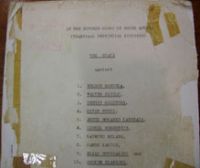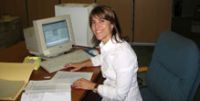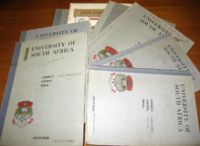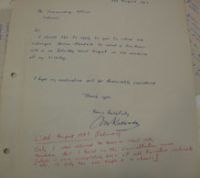
A document from the Rivonia Trial.
(Image: Mayibuye Archives)May 27, 2008 Archival treasures from the life and work of Ahmed Kathrada are emerging at the Mayibuye Archives in Cape Town.
Kathrada is a close comrade and confidante of Nelson Mandela. His boxes of archival material are in the custody of the Mayibuye Archives (Robben Island Museum) at the University of the Western Cape.
Archivist Helen Joannides was seconded by the Nelson Mandela Foundation to help sort through Kathrada’s material.
The boxes hold hundreds of lists, notebooks, study guides, letters and books from his 26 years in prison and beyond.
Kathrada and Mr Mandela are the only surviving accused who were tried in all three major anti-apartheid trials: the 1952 Defiance Campaign Trial, the 1956-1961 Treason Trial and the 1963-4 Rivonia Trial.

Archivist Helen Joannides.
(Image: Nelson Mandela Foundation)They were sentenced to life imprisonment on June 12, 1964, with Walter Sisulu, Govan Mbeki, Andrew Mlangeni, Elias Motsoaledi, Raymond Mhlaba and Denis Goldberg. Kathrada spent 18 years on Robben Island and seven years at Pollsmoor Maximum Security Prison in Cape Town.
After years of struggling for permission to study in prison, Kathrada and others enrolled for degrees by correspondence. Kathrada himself completed a BA in History and Criminology, a B. Bibliography in Library Science and African Politics, and Honours degrees in History and African Politics from the University of South Africa (UNISA). After his release in October 1989, he served on the ANC’s National Executive Committee. He worked as Mr Mandela’s Parliamentary Counsellor during the latter’s five-year term as President of South Africa.
The Ahmed Kathrada Collection is divided into two sections. The first consists of 63 archival boxes which have already been collated. Joannides is working with the second section, of 76 more recently received boxes which date from 1964 to 1999.

Workbooks from Ahmed Kathrada’s studies at Unisa.
The two sets of boxes include documents generated during Kathrada’s prison years and afterwards. Examples of prison documents include correspondence from and to prison authorities, friends, families and colleagues, as well as study materials, assignments, notebooks and lists – hundreds of lists.
It is the overwhelming number of lists that has impressed Joannides the most. “He kept very good, systematic notes: lists of letters he sent out, cross-referenced with when or whether people had received them. He kept lists of toiletries and food that [the prisoners] requested at their own cost, of stationery and books they wanted, and measurements of the prisoners.”
Joannides, who began working on the Ahmed Kathrada Collection in March 2008, has a BA Honours in History and a Masters in Heritage Studies from the University of the Witwatersrand. She said the documents reflect Kathrada’s need to create normality in an abnormal situation. “These were ordinary people with families and loved ones, who ended up in extraordinary circumstances. You see what intelligence and thoroughness there was: they controlled their own destinies as far as they could in the situation.”

Ahmed Kathrada requests time with Mr Mandela on his birthday.
(Image: Mayibuye Collection)Kathrada was chairperson of the Robben Island Museum Council from 1997 to 2006. He left active politics in 1999.
According to Joannides, access to this collection will be important, especially for young people. “Objects and documents can bring the past home to learners very successfully. That’s the power of archives.”
The Nelson Mandela Foundation has worked closely with Joannides on the collection, and she routinely approaches Kathrada for advice on it.
“Kathrada was very excited about the project,” she said. “I think he recognised the importance of maintaining these types of collections and archives. He is very hands-on and said ‘Call me any time, I’ll answer any questions.’”
For her it is a great privilege to be working on the collection. “I have the responsibility to do a good job and to make this collection accessible for the future. And to make [Kathrada] happy! The great thing is we can refer to him if there are things we need clarity and decisions on.”